Which Is Not One Of The Main Types Of Aviation Service?


Pushing a KLM Boeing 777 back
Basis support equipment (GSE) is the back up equipment constitute at an airdrome, ordinarily on the apron, the servicing area by the terminal. This equipment is used to service the aircraft between flights. Every bit the proper name suggests, ground back up equipment is at that place to back up the operations of shipping whilst on the ground. The part of this equipment more often than not involves ground ability operations, shipping mobility, and cargo/passenger loading operations.
Many airlines subcontract ground handling to an airport or a handling amanuensis, or fifty-fifty to another airline. Basis handling addresses the many service requirements of a passenger shipping betwixt the fourth dimension it arrives at a last gate and the fourth dimension it departs for its next flight. Speed, efficiency, and accurateness are of import in basis handling services in order to minimize the turnaround time (the fourth dimension during which the aircraft remains parked at the gate).
Small airlines sometimes farm maintenance to a larger carrier, as information technology may be a better alternative to setting upwardly an independent maintenance base of operations. Some airlines may enter into a Maintenance and Ground Support Agreement (MAGSA) with each other, which is used by airlines to assess costs for maintenance and back up to shipping.[ not verified in torso ]
Most footing services are non directly related to the actual flying of the shipping, and instead involve other service tasks. Cabin services ensure passenger comfort and rubber. They include such tasks as cleaning the rider motel and replenishment of on-board consumables or washable items such as soap, pillows, tissues, blankets, and magazines. Security checks are too fabricated to make certain no threats have been left on the shipping. Airport GSE comprises a diverse range of vehicles and equipment necessary to service aircraft during passenger and cargo loading and unloading, maintenance, and other basis-based operations. The wide range of activities associated with shipping ground operations lead to an every bit wide-ranging fleet of GSE. For instance, activities undertaken during a typical aircraft gate catamenia include: cargo loading and unloading, passenger loading and unloading, potable water storage, lavatory waste tank drainage, aircraft refueling, engine and fuselage exam and maintenance, and food and beverage catering. Airlines employ specially designed GSE to support all these operations. Moreover, electrical power and conditioned air are mostly required throughout gate operational periods for both passenger and crew condolement and condom, and many times these services are also provided by GSE.[1]
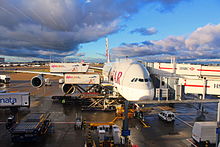
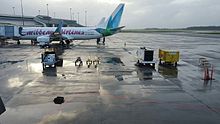
Non-powered equipment [edit]
Dollies [edit]
Dollies for loose baggage are used for the transportation of loose baggages, oversized bags, mail bags, loose cargo carton boxes, etc. between the aircraft and the terminal or sorting facility. Dollies for loose luggage are fitted with a brake system which blocks the wheels from moving when the connecting rod is non attached to a tug. Most dollies for loose baggage are completely enclosed except for the sides which utilize plastic curtains to protect items from atmospheric condition. In the Us, these dollies are chosen Baggage Cart, simply in Europe Luggage Cart means passenger luggage trolleys.
Dollies for unit of measurement load device (ULD) and cargo pallets are standard sized flatbed trolley or platform, with many wheels, roller confined or ball bearings protruding above the top surface for easy loading and unloading of ULD and cargo pallets respectively. Since ULD/pallet rest on ball bearings, these dollies are equipped with swivel/locks to secure the position of the ULD/pallet on them during tugging transportation. The aviation industry adopted ULD/pallets to be lightweight containers and supporting platforms respectively, intended to be loaded into aircraft and fly along with their loads, they need to be minimum in weight and thus exercise not accept wheels or stiff base of operations structure. Besides, the ULD/pallets have stringent dimensional standard following the shipping cargo bay dimension. Therefore, these dollies are custom designed to complement the ULD/pallet's dimension, hinge/fixture position, weak overall physical strength and transportation need. Avant-garde dollies for ULD and pallets, such as those used on an airport apron, may have the following specialized facilities:
- Rollers - Dollies have built-in rollers or balls bearings on the deck to assist in the moving of containers or pallets. Advance dollies have two sets of ability driven rollers, 1 set moves the container forward and backward, and the other movement it left and right. The precise movement is needed to align the center of gravity of the container to the center of the deck, or else the dollies may plow over when in motion. In add-on, the containers or pallets on dollies are secured with built-in locks.
- Revolving platform - Some dollies have a revolving platform to facilitate rotating the ULDs to the right orientation earlier transferring them onto a cargo conveyor chugalug or ULD/pallet lift leading to the aircraft bay. Some revolving platforms are ability assisted.
- Brakes - Dollies have mechanical brakes which automatically lock the dolly wheels when the towbar is in the parked (vertical) orientation, and automatically release the dolly wheels when the towbar is in the towing (horizontal) orientation. No explicit manual locking/unlocking action by the operator is needed.
Dolly fleet direction is an event specific to the drome ground support industry. Dollies are not inexpensive consumable equipment like a hand trolley. Dollies are numerous (thousands) on a big airport apron. An airport usually has more than one dolly fleet operator, using dollies not profoundly dissimilar in appearance, and each operator is using many types of dollies simultaneously. The apron is a big area that using direct eyesight to observe an item is non easy. A dolly in operation needs frequent detachment and re-attachment from the tug and other dollies. Information technology is not admission controlled (it does not need a motorcar key be used, like an car). It is not always supervised by the aforementioned driver (any tractor can come to pick up any dolly and tug them abroad, sometimes erroneously). As a upshot of all above factors, dollies exercise become lost/misplaced on an apron, or at least dollies fleet management is an ongoing burden for ground back up equipment operator. Major airports are starting to attach battery power active RFID tags to dollies to facilitate their fleet management. The agile RFID tags tin exist detected at upward to 100m abroad in open up space from the fixed RFID reader antenna, which can be mounted at the aircraft loading bridges. The RFID tag study the dolly's facility number as well as the "battery weak" and "strong collision" status, making management of the RFID tags (and thus the associated dolly) easier.[2]
- Dolly gallery
-
A single dolly for an aircraft cargo Unit Load Device, next to a grouping of dollies for loose luggage.
-
Those on the left are dollies from People's republic of china Pacific for baggage unit load devices (ULDs). Those on the right are dollies for loose baggage.
-
Dolly for unit load devices
-
Dolly for cargo pallets
Chocks [edit]
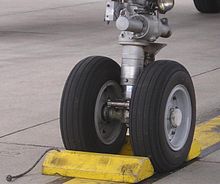

Chocks are used to prevent an aircraft from moving while parked at the gate or in a hangar. Chocks are placed in the front end ('fore') and back ('aft') of the wheels of landing gear. They are made out of hard wood or hard rubber. Corporate safe guidelines in the US near always specify that chocks must exist used in a pair on the aforementioned wheel and they must exist placed in physical contact with the wheel. Therefore, "chocks" are typically found in pairs connected by a segment of rope or cable. The word "chock" is also used as a verb, divers every bit the human activity of placing chocks in front and back of the bike.
Aircraft tripod jack [edit]
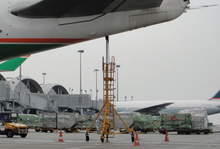
Aircraft jack lift used to back up the tail of an EVA Air Boeing 747 to avert the aircraft tail from falling to ground during the cargo loading/unloading activity in which the "tail heavy" situation may occur.
They are used to support a parked aircraft to prevent their tail from drooping or even falling to the ground. When the passengers in the forepart become off an shipping, the aircraft becomes tail heavy and the tail will droop. Using the jack is optional only not all aircraft demand information technology. When needed, they are tugged to the tail and set up by manpower. One time set upwardly, no supervision to the jack is needed until the aircraft is ready to leave.
Aircraft service stairs [edit]
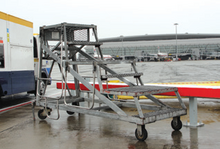
Aircraft service stairs helps the maintenance technician to achieve the bottom of aircraft.
Aircraft service stairs help the maintenance technician to reach the bottom of aircraft.
Powered equipment [edit]
Refuelers [edit]
Aircraft refuelers can be either a self-contained fuel truck, or a hydrant truck or cart. Fuel trucks are self-contained, typically containing upwards to 10,000 US gallons (eight,300 imp gal; 38,000 L) of fuel and have their own pumps, filters, hoses, and other equipment. A hydrant cart or truck hooks into a central pipeline network and provides fuel to the aircraft. There is a meaning advantage with hydrant systems when compared to fuel trucks, every bit fuel trucks must exist periodically replenished.
- Refueler gallery
-

Hydrant truck aircraft refueler.
-

UAZ-23632 based compact tank truck for minor airfields.
Tugs and tractors [edit]
The tugs and tractors at an airdrome take several purposes and represent the essential function of ground back up services. They are used to motility all equipment that can not move itself. This includes bag carts, mobile air workout units, air starters, and lavatory carts.
Basis ability units [edit]
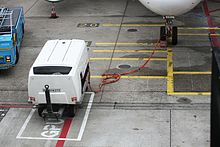
Basis ability unit that needs towing.
A ground ability unit is a vehicle capable of supplying power to shipping parked on the basis. Footing ability units may also exist built into the jetway, making information technology even easier to supply electrical ability to aircraft. Many aircraft require 28 V of direct electric current and 115 V 400 Hz of alternating current. The electric energy is carried from a generator to a connection on the aircraft via iii phase iv-wire insulated cable capable of handling 261 amps (ninety kVA). These connectors are standard for all shipping, every bit defined in ISO 6858.
A so-called "solid state unit" converts power from Air conditioning to DC along with current separation for aircraft power requirements. Solid country units tin can be supplied stationary, span-mounted or every bit a mobile unit.[ commendation needed ]
Buses [edit]
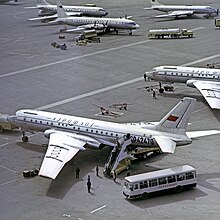
Buses at airports are used to motility people from the terminal to either an aircraft or another final. The specific term for airport buses that bulldoze on the apron just is frock double-decker. Frock buses may have a low profile like the Guangtai or Neoplan aircraft buses because people disembark directly to the frock. Some airports utilise buses that are raised to the level of a passenger concluding and can only be accessed from a door on the 2nd level of the concluding. These odd-looking buses are normally referred to every bit "people movers" or "mobile lounges". Airport buses are usually normal city buses or specialized terminal buses. Specialized airport buses accept very low flooring and wide doors on both sides of the jitney for nearly efficient passenger move and flexibility in depot parking. The biggest producers of drome buses are in China (Weihai, Shenyang, Beijing, Jinhua), Portugal and Slovenia.[ specify ]
Container loader [edit]
Container loaders, also known every bit cargo loaders or "K loaders", are used for the loading and unloading of containers and pallets into and out of aircraft. The loader has two platforms which raise and descend independently. The containers or pallets on the loader are moved with the help of built-in rollers or wheels. In that location are different container and pallet loaders.
- 3.5 T
- 7 T (standard version, wide-body, universal, high)
- fourteen T
- thirty T
For armed services send planes special container and pallet loaders are used. Some military applications use airborne loaders, which are transportable inside the transport plane itself. Container and pallet loaders are mainly produced in France, Deutschland, Republic of latvia, Spain, Canada, Brazil, Japan, Prc, and the United States.
- Container loader gallery
-
Aircraft container and pallet loader with numerous powered Mecanum cycle for shifting and rotation of containers.
-

A ULD loader lifting a unit of measurement load device (ULD) from apron dollies to an aircraft's cargo bay
Transporters [edit]

Transporters are cargo platforms synthetic so that, beside loading and unloading containers, they can also transport the cargo. These transporters are not typically used in the U.s..
Air commencement unit [edit]
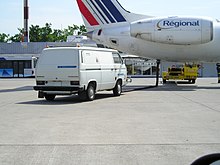
An air commencement unit (as well known equally a "start cart") is a device used to kickoff an shipping's engines when it is not equipped with an on-board APU or the APU is non operational. There are three principal types of these devices that exist currently: a stored air cart, a gas turbine based unit, and a diesel engine driven screw compressor unit of measurement. All three devices create a source of depression force per unit area, high volume air to start the aircraft engines. Typically one or two hoses are connected to these units, with the largest shipping engines requiring three.
Non-potable h2o trucks [edit]
Non-potable water trucks are special vehicles that provide water to an aircraft. The water is filtered and protected from the elements while existence stored on the vehicle. A pump in the vehicle assists in moving the water from the truck to the aircraft. The water is designated every bit not-drinkable.
Lavatory service vehicles [edit]

A human connects the waste suction hose to the lavatory service outlet on the underbelly of a C-17 Globemaster 3, enabling him to suck the waste matter into a tank in the truck shown in the background.
Lavatory service vehicles empty and refill lavatories onboard aircraft. Waste material is stored in tanks on the aircraft until these vehicles can empty them and remove the waste product. Later the tank is emptied, information technology is refilled with a mixture of h2o and a disinfecting concentrate, ordinarily called 'blue juice'. Instead of a self-powered vehicle, some airports take lavatory carts, which are smaller and must be pulled by tug.
Catering vehicle [edit]
The catering vehicle consists of a rear body, lifting arrangement, platform and an electro-hydraulic control mechanism. The rear body can be lifted up, downwardly and the platform tin can exist moved to place in front of the aircraft.
Catering services include the unloading of unused food and drink from the aircraft, and the loading of fresh food and drinks for passengers and coiffure. The meals are typically delivered on standardized carts which are wheeled into the catering vehicle. Meals are prepared generally on the basis in order to minimize the amount of preparation (apart from chilling or reheating) required during flying.
The vehicle then drives to the drome and is parked in front of the plane. The stabilizers are deployed and the van body is lifted. The platform can be fine controlled to move left-right equally well as in-out so that it is aligned with the door correctly. The torso is made of insulated panels and is capable of maintaining temperatures of 0 °C (32 °F) past means of refrigeration unit of measurement.
In-flight nutrient is prepared in a flight kitchen facility, a completely HACCP certified facility where nutrient is reheated in sterile and controlled environments. The prepared food is then placed in trollies and wheeled into the cabin.
A predecessor to the catering truck was in apply by the U.Due south. Ground forces Air Forces during Earth War Ii.[3]
A special college type of catering truck has been designed to accommodate the Airbus A380.
- Catering vehicle gallery
-
Two Shipping Catering Vehicles serving an aircraft
-
Belt loaders [edit]
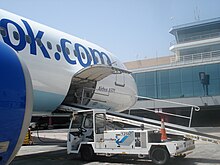
Belt loaders are vehicles with conveyor belts for unloading and loading of luggage and cargo onto aircraft. A belt loader is positioned at the door sill of an aircraft concur (baggage compartment) during operation. Belt loaders are used for narrowbody aircraft, and the bulk concord of wide trunk aircraft. Stowing baggage without containers is known every bit bulk loading.
Passenger boarding steps/stairs [edit]

Passenger boarding stairs
Rider boarding stairs, sometimes referred to as boarding ramps, stair car or aircraft steps, provide a mobile means to traverse between the shipping doors and the ground. Because larger aircraft have door sills 5 to 20 feet loftier, stairs facilitate safe boarding and deplaning. Smaller units are more often than not moved by beingness towed or pushed, while larger units are self-powered. Most models have adaptable height to adapt various aircraft. Optional features may include canopies, heating, supplementary lighting, and a red carpet for VIP passengers. Larger aircraft may use one or more jet bridges connected to the terminal edifice for passenger boarding, but ground-based stairs are used when this is unavailable or impractical.
Pushback tugs and tractors [edit]
Pushback tugs are mostly used to push an aircraft abroad from the gate when information technology is set up to leave. These tugs are very powerful and considering of the large engines, are sometimes referred to every bit an engine with wheels. Pushback tugs tin also be used to pull shipping in various situations, such every bit to a hangar. Dissimilar size tugs are required for different size aircraft. Some tugs use a tow-bar equally a connexion between the tug and the aircraft, while other tugs elevator the olfactory organ gear off the ground to arrive easier to tow or push. Recently there has been a button for towbarless tractors as larger airplanes are designed.
- Tugs and tractors gallery
-
A pushback tug with towbar fastened
-
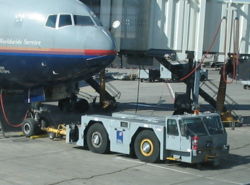
De/anti-icing vehicles [edit]

The process of de/anti-icing, protection from fluids freezing up on shipping, is done from special vehicles. These vehicles take booms, like a ruby picker, to allow like shooting fish in a barrel admission to the entire aircraft. A hose sprays a special mixture that melts current ice on the aircraft and also prevents some ice from building up while waiting on the basis.
Aircraft rescue and firefighting [edit]

Aircraft rescue and firefighting is a special category of firefighting that involves the response, hazard mitigation, evacuation and possible rescue of passengers and crew of an aircraft involved in (typically) an airport ground emergency.
Run into also [edit]
- AERO Specialties
- Aircraft ground handling
- Airline service trolley
- Air-beginning organization
- Bag ramp
- Baggage tug
- Charging station
- Electrical cart
- Electric truck
- Hydraulics International, INC.
- Non-road engine
- Pushback
- TLD (disambiguation)
- Visual Guidance Docking Systems (VGDS)
- Mercury GSE
- Height Logistics
References [edit]
- ^ Technical Support for Development of Drome Ground Back up Equipment Emission Reductions
- ^ Munich Airport Says RFID Improves Dolly Management
- ^ Handbook of Instructions with Parts Itemize: Hi-Lift Aeroplane Loader Truck (Technical study). ane August 1944. AN xix-25-77.
External links [edit]
- TLD Group TLD Group - Official website
- Terberg Aviation Terberg Aviation - Official website
- Mercury GSE Mercury GSE - Official website
Source: https://en.wikipedia.org/wiki/Ground_support_equipment
Posted by: hardinsinke1957.blogspot.com







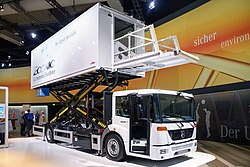


0 Response to "Which Is Not One Of The Main Types Of Aviation Service?"
Post a Comment